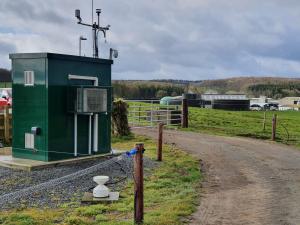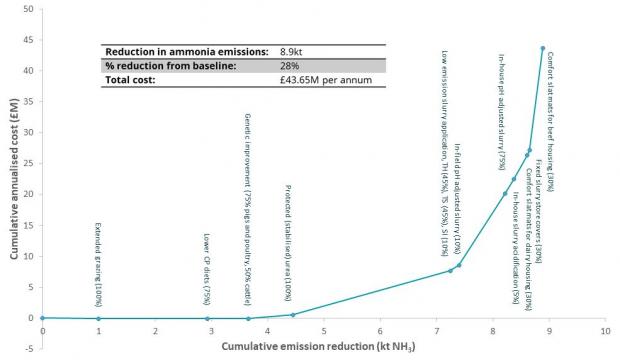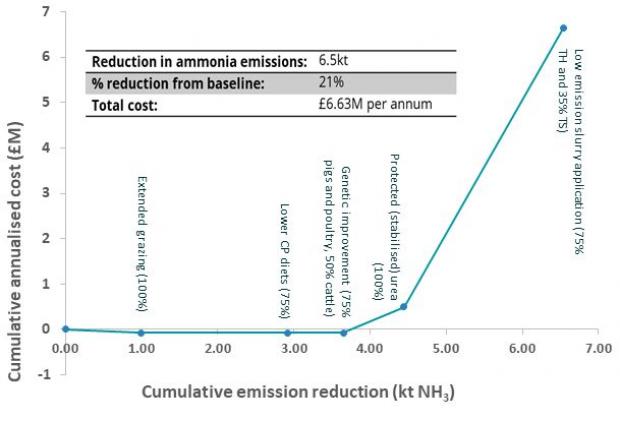Ammonia emissions from livestock present major challenges to the Northern Ireland agricultural industry. Funded by the Department of Agriculture, Environment and Rural Affairs, the Agri-Food and Biosciences Institute (AFBI) is currently conducting a major programme of research and have released this series of articles to help stakeholders understand the issue and adopt effective solutions.

As outlined in the two previous articles in this series, the adoption of measures to reduce ammonia emissions is key to improving air quality and complying with international air quality agreements. However, the cost of a reduction measure is highly likely to influence the rate of adoption by farmers. To enhance the likelihood of adoption, AFBI, in partnership with Rothamsted Research in the UK, has led on identifying cost-effective strategies for reducing ammonia emissions within a large DAERA commissioned research programme addressing ammonia emissions in Northern Ireland.
The ammonia reduction measures
The ammonia reduction measures chosen were largely drawn from those recommended by the Expert Working Group (EWG) on Sustainable Agricultural Land Management for Northern Ireland in their “Making Ammonia Visible” report, as well as consultation with DAERA. These also aligned with the measures adopted to estimate the resultant level of ammonia emissions and their impact on nitrogen deposition reported in previous articles. The measures were:
Extended grazing by two weeks;
- Lower crude protein diets for housed dairy cows;
- Genetic improvement for cattle, pig and poultry;
- Replacing urea fertiliser with protected (stabilised) urea;
- Low emission slurry application by trailing hose (TH), trailing shoe (TS) and shallow injection (SI);
- Increased scraping frequency in buildings for dairy cows;
- Washing down of collecting yards – scraping before washing;
- pH adjustment of slurry in-field
- Livestock housing for pigs and poultry i.e. use of air scrubbers;
- pH adjustment of slurry in-house for pigs and cattle;
- Comfort slat mats – beef and dairy cattle and;
- Fixed slurry store covers on outdoor slurry tanks.
(It should be noted that pH adjustment methods were not in the EWG recommendations but were considered a potentially significant reduction option based on a large body of scientific research).
Costs of ammonia reduction measures
In calculating the total costs to the farmer, capital investment and annual running costs were combined by adding the annual charge of the capital element to the estimated annual running costs. The annual charge was derived by ‘paying off’ the investment over the anticipated life (or write-off period) at an interest rate of approximately 7% for most investments. Units of measurement for costs of diet, grazing and housing measures were expressed per animal place, per m3 of slurry for slurry storage and spreading measures, or per kg of nitrogen applied for fertiliser measures.
Extending the grazing season for cattle by 2 weeks resulted in a saving of £9.50 per animal place. The next least expensive reduction measures were found to be lower crude protein in the diet for housed dairy cows; genetic improvement for pigs and poultry; low emission spreading techniques; stabilised urea fertiliser; pH adjustment in-field of slurry and retrofitting fixed covers on above ground circular slurry tanks. The costs for these ranged from £0 to £2.44 per annum per unit of measurement. The most expensive reduction measures had a cost range of £12.94 to £90.77 per annum per unit of measurement. These included comfort slat mats for dairy and beef cattle; pH adjustment of slurry in house for dairy and pigs; washing down of collecting yards for dairy cows and low emission livestock housing with air scrubbers for pigs.
Cost effectiveness: The Marginal Abatement Cost Curve
In order to assess how effective the above investments would be with regard to abating ammonia, an economic modelling exercise was conducted to establish a ‘Marginal Abatement Cost Curve (MACC)’. A MACC provides a graphic visual of abatement potential (horizontal axis of the graph) and associated costs (vertical axis of the graph) of applying the ammonia reduction measures, taking into account interactions between measures.
In order to build the MACC, the emissions reductions possible by each abatement method was established. This data was combined with the ‘cost’ data noted above, and, following these procedures, the most cost-effective (i.e. most ammonia abated for the money invested) reduction measures were identified as:
- Extending the grazing season for cattle by two weeks (which saved £0.07 for every kg of ammonia abated);
- Lowering crude protein (CP) diets for livestock which was cost neutral;
- Genetic improvement in pigs and poultry was also cost neutral;
- Using stabilised urea fertiliser (generated a cost of £0.72 per kg of ammonia abated);
- Low emission spreading techniques. Trailing shoe had a cost of £1.79 per kg of ammonia abated while trailing hose had a cost of £3.03 and shallow injection had a cost of £2.67 per kg of ammonia abated;
- Increased frequency of scraping in dairy cattle housing is estimated to cost £0.32 per kg of ammonia abated (mechanical scraping was assumed so the cost excluded the cost of labour).
On the other hand, the following measures were not as cost-effective:
- pH adjustment of slurry in-house for dairy cows and pig finishers attracted a cost of £9.68 per dairy cow and £9.84 per pig per kg of ammonia abated;
- Washing of hard-standings/collecting yards had a cost of £11.07 per kg of ammonia abated;
- Using air scrubbers in pig and poultry housing had a cost of £13.39 per kg of ammonia abated;
- Retrofitting fixed covers on circular slurry stores cost £20.55 per kg of ammonia and;
- Comfort slat mats cost £15.99 for dairy cows and £71.45 for beef animals per kg of ammonia abated.
When this data was incorporated into a MACC 1 (Figure 1) it was concluded that the implementation of all eleven measures would give an overall reduction of 8.9 kilo tonnes (28%) of ammonia emissions across NI, at a total cost of £43.65M per annum compared to business as usual ammonia emissions and holding livestock numbers constant. The implementation rates were chosen on the basis of them being ambitious but achievable over a 5 to 10 year timeframe.

The data in Figure 1 demonstrated that the five low cost measures had the ability to abate a significant amount of ammonia (horizontal axis) and so a second scenario was developed MACC 2 (Figure 2) which focused only on the five lowest cost ammonia reduction measures (i.e. extended grazing, lower CP diets for livestock, stabilised urea, low emission slurry application and genetic improvement for cattle, pigs and poultry).

The MACC 2 model indicates that the implementation of these five measures gives an overall reduction of 6.5 kilo tonnes (21%) of ammonia emissions across NI, at a total cost of £6.6M per annum compared to business as usual ammonia emissions and holding livestock numbers constant.
Overall, reducing ammonia emissions in NI will require investment, but it is noteworthy that through the adoption of the 5 most cost-effective measures, a 21% reduction could be established, which would significantly contribute to the achievement of targets as set by international protocols and national legislation.
Over the coming weeks, this series of articles focusing on the AFBI research programme to address ammonia emissions in NI will outline the work being undertaken in more detail and the key findings to date. Next week’s article will focus on the ammonia monitoring research which AFBI are undertaking across NI to better understand the cause and effect between farm activities and ammonia concentrations as well as ground truthing modelled ammonia concentration estimates.
You can view previous articles in the series below:
- Article 1: Tackling Agricultural Ammonia Emmissions in Northern Ireland
- Article 2: Reducing Ammonia Emmissions across Northern Ireland
Notes to editors:
AFBI is an arms-length body of DAERA delivering research and development, diagnostic and analytical testing, emergency response capability and expert scientific advice for DAERA and other government departments, public bodies and commercial companies in Northern Ireland, and further afield.
AFBI’s Vision is “Advancing the Local and Global Agri-Food Sectors Through Scientific Excellence”.
AFBI’s core areas:
- Leading improvements in the agri-food industry;
- Protecting animal, plant and human health;
- Enhancing the natural and marine environment.
Latest news
- Resilience, Sustainability and Innovation survey 03 March 2025
- AFBI led Project Launched to Promote Sustainable Dairy Farming across the UK 18 February 2025
- UK Project Launched to Promote Sustainable Dairy Farming 11 February 2025
- International Day of Women and Girls in Science 11 February 2025
